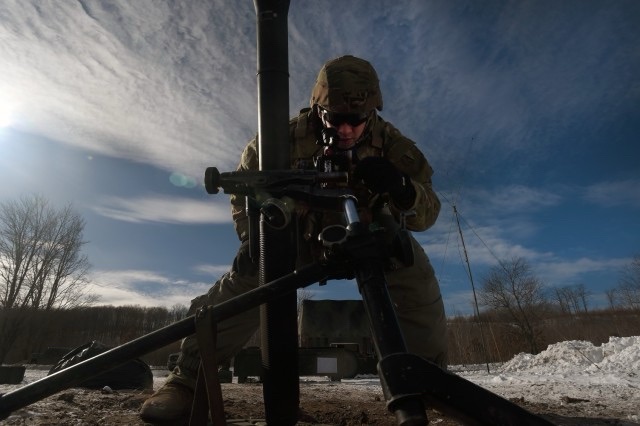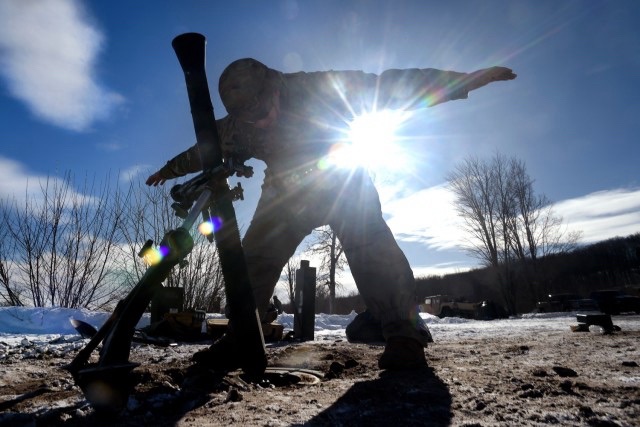
CAMP GRAYLING, Mich. – A frigid winter wind fluttered past the snow-covered landscape as Sgt. Shane Vanderhoek, an indirect fire infantryman with Headquarters and Headquarters Company, 1st Battalion, 125th Infantry Regiment, Michigan Army National Guard, adjusted his team’s 81 mm mortar.
Hunched over the mortar’s sights, the sun lit up his breath steamy and bright each time he exhaled while painstakingly making the needed adjustments. Though seemingly minor in their movement, each change took longer to make than expected.
“Everything is just cold,” he said. “A lot of our equipment takes longer to start to work, or it just doesn’t really like working.”
Learning to navigate those cold weather issues is one of the goals of exercise Northern Strike 24-1, a weeklong winter warfare training exercise hosted by the Michigan National Guard. Vanderhoek and his unit supported friendly elements while squaring off against both opposing forces and Arctic-like conditions.
“This just offers that extreme weather and the ability to test your ability to maneuver and to test your unit’s ability to function and plan in a totally different environment,” said Army Col. Todd Fitzpatrick, the officer in charge of the exercise’s ground elements. “With the temperatures we have, it closely replicates a near-Arctic environment.”
Held at Camp Grayling Maneuver Training Center and the Alpena Combat Training Center — which together comprise the Michigan Guard’s National All-Domain Warfighting Center — the exercise’s location and terrain make it and the National Guard key elements of the Department of Defense’s Arctic strategy, said Fitzpatrick.

“Obviously, Alaska is an ideal [cold weather] environment to train in,” he said, adding that getting units and their equipment to Alaska for training can be both difficult and expensive. “So, this offers a very similar climate, very similar complex terrain and just is cost-effective for units to do that near-Arctic training.”
Northern Strike 24-1 focused on integrated air and ground operations. Elements of the Army’s 5th Special Forces Group operated with close air support from Air Force and Michigan Air National Guard units while Michigan Army Guard units provided mortar and helicopter support.
The joint focus is another key element of the exercise, said Fitzpatrick.
“It’s really integral to Northern Strike because this is such a valuable training area for the joint force — air, maritime, land component — and, more importantly, across all domains of warfare,” he said. “The jointness and the all-domain nature of the exercise are really what separates it from others.”
Northern Strike began in 2011, typically taking place each August and often including participants from all U.S. military services and components as well as international partners. It was expanded to include a winter portion in 2020 after feedback, specifically from special operations forces, indicated a need for cold weather training.
“It was actually a demand from rotational units,” said Fitzpatrick. “SOF-oriented units wanted a place to train the way we do in a near-Arctic or winter setting with a complex maneuver space like we have here.”

While the winter portion of the exercise is typically smaller — this year’s iteration included about 200 participants while the summer exercise often includes more than 7,000 — its challenges are no less complex.
For Fitzpatrick, those challenges include ensuring the exercise meets or exceeds the training needs of participating units.
“It’s not a cookie-cutter exercise,” he said. “We like to say that every unit is the main event. So, it’s challenging deconflicting all that training, integrating those joint, multinational, multicomponent partners.”
Planning starts about a year ahead of the exercise rotation.
“Because we have two exercises, we have two [planning] cycles running,” he said. “And, of course, we’re looking into the future. We’re already scheduling units for 2025 and beyond.”
For Vanderhoek and many other units on the ground, the challenges are often more immediate, such as ensuring the mortar’s baseplate is emplaced properly.
“We like to dig little holes if we’re operating in a place just so the base plate can settle down easier,” he said. “Obviously, it takes longer when the ground’s frozen to do that.”
The frozen ground also makes it more difficult to ensure the mortar’s bipod support legs are dug in. Simply placing them on the ground means the mortar may move.
“Then we’re running the risk of the legs sliding out when we’re firing, which will cause a round to go somewhere completely different [than intended].”
None of those were challenges faced by the unit during its recent deployment to the Middle East, but the winter iteration of Northern Strike prompted them to find solutions to those challenges.
Though it took longer than expected, Vanderhoek dialed in the needed adjustments to the mortar.
“Gun 1 is up,” he called out. Shortly after, another Soldier came out of the tent that served as the fire direction center.
“Fire mission!” he shouted, as Vanderhoek and his team scrambled into position to execute.
By SFC Jon Soucy, National Guard Bureau

